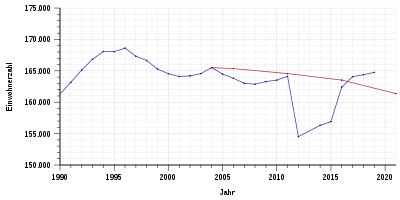Population development in Osnabrück
This article shows the population development of Osnabrück in tabular and graphical form.
Population development
The bishopric of Osnabrück, founded by Charlemagne in 780 , had around 800 inhabitants at that time. In the late Middle Ages and the early modern period in the village only a few thousand people lived. In 1575 around 75 percent of Osnabrück's inhabitants died of the plague . Because of the following epidemics, conflagrations, famines and wars, it took around 200 years until the population before the outbreak of the plague of 1575 was reached again.
With industrialization in the 19th century, the population quintupled from over 10,000 in 1817 to more than 50,000 in 1900. The development of the railway junction , which required a lot of labor , had a major influence on this . On April 1, 1914, the incorporation of the village of Schinkel brought an increase from 9,676 people to around 80,000 inhabitants. In 1939 the population of the city of Osnabrück exceeded the limit of 100,000, making it a major city . On April 1, 1940, Haste was incorporated with 7,279 inhabitants.
During the Second World War , the city of Osnabrück was the target of 78 Allied air raids. 178 people died in the last and most serious attack on March 25, 1945. Overall, the bombing war resulted in 1,434 deaths - including 268 prisoners of war, prisoners and forced laborers . The urban area was destroyed to more than 65 percent; the mediaeval old town was hit hardest at 94 percent (→ main article: air raids on Osnabrück ). On April 4, 1945, British forces occupied the city. The population fell to 82,000 by December 1945, but rose to 140,000 by 1962 as a result of the return of the evacuees and the influx of refugees and displaced persons from the eastern German regions.
On July 1, 1972, the incorporation of Atter, Pye, Lüstringen, Gretesch, Darum, Voxtrup, Nahne and Hellern brought an increase from 22,759 people to 164,000 inhabitants. In 1995 the population reached its historic high of 168,618. On December 31, 2006, the " official population " for Osnabrück was 164,020 according to an update by the Lower Saxony State Office for Statistics (only main residences and after comparison with the other state offices).
The following overview shows the number of inhabitants according to the respective territorial status. Up to 1823 these are mostly estimates, then census results (¹) or official updates by the city administration (until 1970) and the State Statistical Office (from 1971). From 1855 the information relates to the “customs clearance population”, from 1871 to the “local population”, from 1925 to the resident population and since 1987 to the “population at the place of the main residence”. Before 1855, the number of inhabitants was determined according to inconsistent survey methods.
The population is determined by the 2011 census 154,513 (December 31, 2011).
From 780 to 1944
(respective territorial status)
|
|
|
¹ census result
From 1945 to 1970
(respective territorial status)
|
|
|
¹ census result
Source: Osnabrück City Administration
Since 1971
(respective territorial status)
|
|
|
¹ census result
Source: Lower Saxony State Office for Statistics
2011 according to the 2011 census
Population forecast
In their 2006 “Guide to Demographic Change 2020”, in which the Bertelsmann Foundation provides data on the development of the population of 2,959 municipalities in Germany, a population decline of 2.5 percent (4,144 people) between 2003 and 2020 is predicted for Osnabrück .
Absolute population development 2003-2020 - forecast for Osnabrück (main residences):
|
Source: Bertelsmann Foundation
Population structure
| population | As of December 31, 2006 | percentage |
|---|---|---|
| Residents with main residence | 163.020 | 100% |
| male | 77,667 | 48% |
| Female | 85.353 | 52% |
| German | 149,543 | 92% |
| male | 70,772 | 43% |
| Female | 78,771 | 48% |
| Foreigners | 14,718 | 9% |
| male | 7,528 | 5% |
| Female | 7.190 | 4% |
Source: Lower Saxony State Office for Statistics
age structure
The following overview shows the age structure as of December 31, 2006 (main residences).
|
Source: Lower Saxony State Office for Statistics
Districts
The population figures refer to December 31, 2007 (main residences).
| Surname | Area in km² |
of inhabitants number |
Inhabitants per km² |
Number of foreigners |
Foreigners in% |
|---|---|---|---|---|---|
| Atter | 10.76 | 4.018 | 373 | 235 | 5.8 |
| That's why / Gretesch / Lüstringen | 14.33 | 7,444 | 519 | 435 | 5.8 |
| Dodesheide | 4.49 | 7,583 | 1,689 | 636 | 8.4 |
| Eversburg | 2.96 | 7,888 | 2,665 | 679 | 8.6 |
| Fledder | 3.75 | 2,470 | 659 | 436 | 17.7 |
| Garden location | 1.69 | 3,620 | 2.142 | 561 | 15.5 |
| port | 4.07 | 2,373 | 583 | 277 | 11.7 |
| have you | 7.89 | 6,622 | 839 | 563 | 8.5 |
| Lighten | 12.26 | 6,788 | 554 | 295 | 4.3 |
| Downtown | 1.63 | 8,249 | 5,061 | 1,122 | 13.6 |
| Limestone hill | 3.01 | 5,921 | 1,967 | 753 | 12.7 |
| Nahne | 4.85 | 2,218 | 457 | 105 | 4.7 |
| Pye | 7.56 | 3,236 | 428 | 107 | 3.3 |
| Schinkel | 2.23 | 13,234 | 5,935 | 2,674 | 20.2 |
| Schinkel-Ost | 2.93 | 3,478 | 1,187 | 300 | 8.6 |
| Schölerberg | 3.45 | 13,914 | 4.033 | 1,664 | 12.0 |
| Sun hill | 3.17 | 8,340 | 2,631 | 600 | 7.2 |
| Sutthausen | 4.48 | 4,695 | 1,048 | 157 | 3.3 |
| Voxtrup | 10.93 | 6,990 | 640 | 347 | 5.0 |
| Westerberg | 4.81 | 8,513 | 1,770 | 402 | 4.7 |
| West town | 3.10 | 8,608 | 2,777 | 615 | 7.1 |
| Widukindland | 2.71 | 4,759 | 1,756 | 459 | 9.6 |
| desert | 2.77 | 14,110 | 5,094 | 1,056 | 7.5 |
| Osnabrück | 119.81 | 155.071 | 1,294 | 14,478 | 9.3 |
Source: City of Osnabrück, Department for Urban Development and Citizen Participation, Statistics Division
literature
- Imperial Statistical Office (Hrsg.): Statistical yearbook for the German Empire. 1880-1918
- Statistisches Reichsamt (Ed.): Statistical yearbook for the German Reich. 1919–1941 / 42
- German Association of Cities (Hrsg.): Statistical yearbook of German municipalities. 1890 ff.
- Federal Statistical Office (Hrsg.): Statistical yearbook for the Federal Republic of Germany. 1952 ff.
- Bertelsmann Stiftung (Ed.): Guide to Demographic Change 2020. Analyzes and action plans for cities and municipalities. Bertelsmann Stiftung Publishing House , Gütersloh 2006, ISBN 3-89204-875-4 .
Individual evidence
- ↑ City of Osnabrück: Residents by age group and nationality in the districts (PDF; 15 kB)



